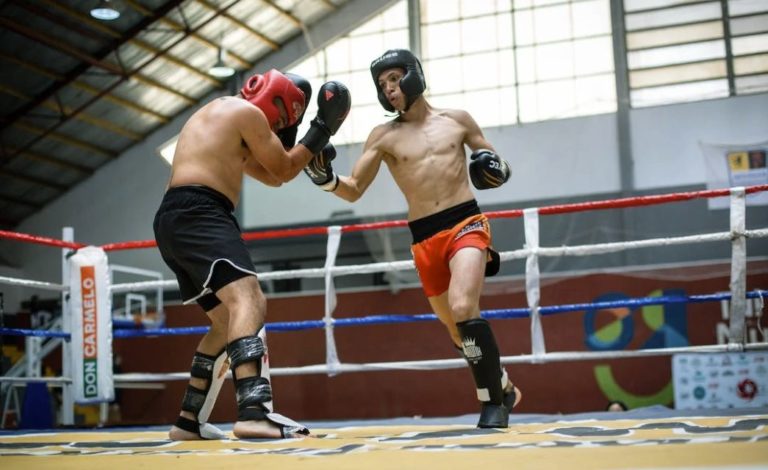How to Get Into Boxing?
Boxing is a combat sport in which two participants, typically wearing protective gloves, throw punches at each other within a defined boxing ring. The objective is to outscore or knock out the opponent while adhering to specific rules and regulations.
If you're considering getting into boxing, the first step is to find the right gym that aligns with your goals and needs. Look for a facility with experienced coaches and adequate training equipment.
After selecting a suitable gym, the next step is to invest in essential gear, such as gloves and hand wraps.
In this post, we will explore how to effectively develop your skills and maintain motivation throughout your boxing journey, as understanding these elements can greatly influence your progress and enjoyment in the sport.
Understanding Boxing Basics
To start your boxing journey, you should know the fundamental techniques and rules of the sport. Boxing may be a blend of skill, strategy, and discipline, rather than just throwing punches.
Familiarize yourself with the two basic stances: orthodox for right-handed fighters and southpaw for left-handed fighters.
Next, focus on mastering the four primary punches: the jab, cross, hook, and uppercut, as each may serve a specific purpose in your boxing strategy. Additionally, practicing footwork may help you evade punches and create angles for effective strikes.
Understanding the rules may be crucial for your success. You should know the scoring system and the importance of clean hits over illegal strikes, such as low blows or hitting behind the head.
Familiarity with the structure of rounds and the concept of a knockout may also enhance your boxing knowledge. By grasping these basics, you may build a solid foundation for your boxing skills, allowing you to practice safely and effectively.
Choosing the Right Gym
Finding the right gym for boxing is essential for your training. Look for a gym with a convenient location and hours that fit your schedule to encourage regular attendance.
Ensure the gym has proper facilities, including punching bags, gloves, and a boxing ring. Access to cardio and strength training equipment may also enhance your overall performance.
Research the coaches' experience and credentials, as having a knowledgeable coach may help you learn the basics and challenge you to improve. Observing a few classes can give you insight into their coaching style.
The gym's atmosphere is important; a supportive environment may positively influence your progress. Speak with current members to gauge the gym culture.
Essential Gear and Equipment
Having the right gear and equipment is crucial for boxing training to ensure performance and safety.
Essential items include boxing gloves, which may protect your hands and your opponent. Hand wraps may provide extra support to your wrists and knuckles, reducing injury risk. Headgear is important for sparring, as it may reduce the impact of punches to your head.
A mouthguard may safeguard your teeth and jaw while allowing comfortable breathing. Boxing shoes may offer traction and support, aiding balance and agility.
Lastly, a jump rope may be an effective tool for improving stamina through conditioning and footwork drills. With the right gear, you may step into the ring with confidence and focus on your training.
Learning Techniques and Skills
Mastering fundamental techniques and skills is essential for developing boxing proficiency and ensuring effective training.
Start with your stance; a good balance and posture may allow you to move quickly and react effectively. Practice the basic punches: jab, cross, hook, and uppercut, focusing on proper form to maximize power and minimize injury.
Footwork may be equally important. Work on moving in and out, side to side, and pivoting to maintain balance while staying evasive. Shadowboxing may be a beneficial way to combine these elements. Visualizing an opponent and practicing punches and footwork in front of a mirror may help refine your technique.
Defense may not be overlooked. Learning to slip, block, and roll with punches may protect you while creating openings for counters. Incorporating defensive drills into your training routine may help build muscle memory.
Consider working with a coach or joining a boxing gym. They may provide personalized feedback, helping you identify areas for improvement.
Developing a Training Routine
Creating a consistent training routine may help reinforce the techniques and skills you've learned while ensuring steady progress in your boxing journey.
Set specific goals, such as improving footwork, increasing punch speed, or boosting stamina. Break your routine into focused sessions throughout the week.
Incorporate a mix of shadowboxing, bag work, and sparring to hone your skills. For example, dedicate a day to technique drills and another to strength training. Include cardio workouts like running or jump rope to enhance endurance.
Aim for at least three to five training sessions per week, depending on your schedule and current fitness level. Always warm up before each session and cool down afterward to prevent injuries. Track your progress and adjust your routine as needed to challenge yourself and keep things fresh.
Nutrition and rest may be vital for peak performance. By adhering to this routine, you may build a solid foundation in boxing, allowing you to develop your skills effectively and efficiently.
Staying Motivated and Committed
Staying motivated and committed to your boxing training is crucial for achieving your goals and overcoming challenges. To maintain motivation, set clear, achievable goals and break them down into smaller milestones. Celebrate each milestone you reach.
Surrounding yourself with supportive individuals may enhance your training experience. Training with friends or at a boxing gym can connect you with like-minded people, whose energy may inspire you even on tough days.
Making your training enjoyable is important; experimenting with different workouts or techniques may keep things fresh and exciting. Activities like shadow boxing, bag work, or sparring may help maintain your enthusiasm.
–
What Is the Best Age to Start Boxing Training?
The best age to start boxing training may be around 8 to 10 for kids, as they can typically grasp the basics at this age.
For adults, it may never be too late to start, as many people begin training in their teens or even later.
What matters most may be your commitment to training and your desire to learn.
How Do I Find a Boxing Mentor or Coach?
To find a boxing mentor or coach, start by visiting local gyms and inquiring about their trainers.
Look for someone with experience and a teaching style that resonates with you.
You may also consider joining online boxing communities or forums to connect with coaches.
Asking for recommendations from fellow fighters or enthusiasts may be beneficial as well.
Once you have a few options, it may help to try a few sessions to see who suits you best.
Are There Specific Dietary Recommendations for Boxers?
Yes, there are specific dietary recommendations for boxers. Your diet may play a vital role in performance, so you should focus on lean proteins, complex carbs, and healthy fats to fuel your workouts.
Incorporating fruits and vegetables may provide essential vitamins and minerals. Staying hydrated is important, and timing your meals around training sessions may help optimize energy levels.
It may also be beneficial to consult a nutritionist to tailor your diet to your individual needs and goals.
Can I Practice Boxing at Home Without a Gym?
Yes, you can practice boxing at home without a gym!
Start by setting up a small training area with enough space to move around. You may want to invest in a heavy bag or shadowbox to work on your technique.
Online tutorials may help you learn proper footwork, punches, and combinations.
Don't forget to incorporate strength and conditioning exercises, as they may help build your stamina.
With consistency and dedication, you may see progress right in your living room!
What Are the Typical Costs Associated With Boxing Training?
The typical costs associated with boxing training may vary based on several factors.
You may need to invest in gear like gloves, hand wraps, and mouthguards, which may range from $50 to $300.
If you're considering private lessons, you may expect to pay between $30 to $100 per session.
Gym memberships may usually cost around $30 to $100 monthly.


